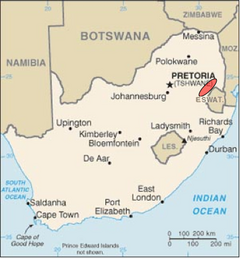Fig Tree Formation
Appearance
| Fig Tree Formation | |
|---|---|
| Stratigraphic range: Paleoarchean ~ | |
| Type | Geological formation |
| Unit of | Barberton Supergroup |
| Underlies | Moodies Group |
| Overlies | Onverwacht Group |
| Lithology | |
| Primary | Sandstone |
| Other | Shale |
| Location | |
| Location | Kaapvaal Craton |
| Coordinates | 25°48′S 31°00′E / 25.8°S 31.0°E |
| Region | Barberton Greenstone Belt, Mpumalanga |
| Country | South Africa |
 Location of the Barberton Greenstone Belt | |
The Fig Tree Formation, also called Fig Tree Group, is a stromatolite-containing geological formation in South Africa. The rock contains fossils of microscopic life forms of about 3.26 billion years old.[1] Identified organisms include the bacterium Eobacterium isolatum and the algae-like Archaeosphaeroides barbertonensis. The fossils in the Fig Tree Formation are considered some of the oldest known organisms on Earth, and provide evidence that life may have existed much earlier than previously thought. The formation is composed of shales, turbiditic greywackes, volcaniclastic sandstones, chert, turbiditic siltstone, conglomerate, breccias, mudstones, and iron-rich shales.[2]
See also
[edit]References
[edit]Further reading
[edit]- "Fig Tree microfossils". Encyclopædia Britannica Online. Encyclopædia Britannica Inc. 2016. Retrieved Oct 9, 2016.
- Byerly G.R., Lower D.R. & Walsh M.M. (1986). Stromatolites from the 3300–3500-Myr Swaziland Supergroup, Barberton Mountain Land, South Africa. Nature, 319: 489–491.
